Management Accounting Report: Variance Analysis and XLG Case Study
VerifiedAdded on 2023/01/09
|13
|3250
|81
Report
AI Summary
This report delves into the core concepts of management accounting, commencing with an introduction that underscores its significance in modern corporate decision-making. The initial section, Part A, provides a detailed examination of variance analysis, including the calculation of sales price and volume contribution variances for Chemical X and Y, as well as material price planning and operational variances. It critically assesses the merits and demerits of using variances in evaluating managerial performance, offering insights into their advantages and limitations. Part B shifts the focus to a case study involving XLG, a cleaning agent manufacturer, evaluating strategic alternatives, particularly the in-house production of Fama Q, considering factors such as patent protection, supply chain disruptions, and market demand fluctuations. The report concludes with recommendations based on the analysis, highlighting the financial implications of each decision, like changes in profit margins and cost optimization strategies, providing a comprehensive overview of the financial and operational considerations for XLG.
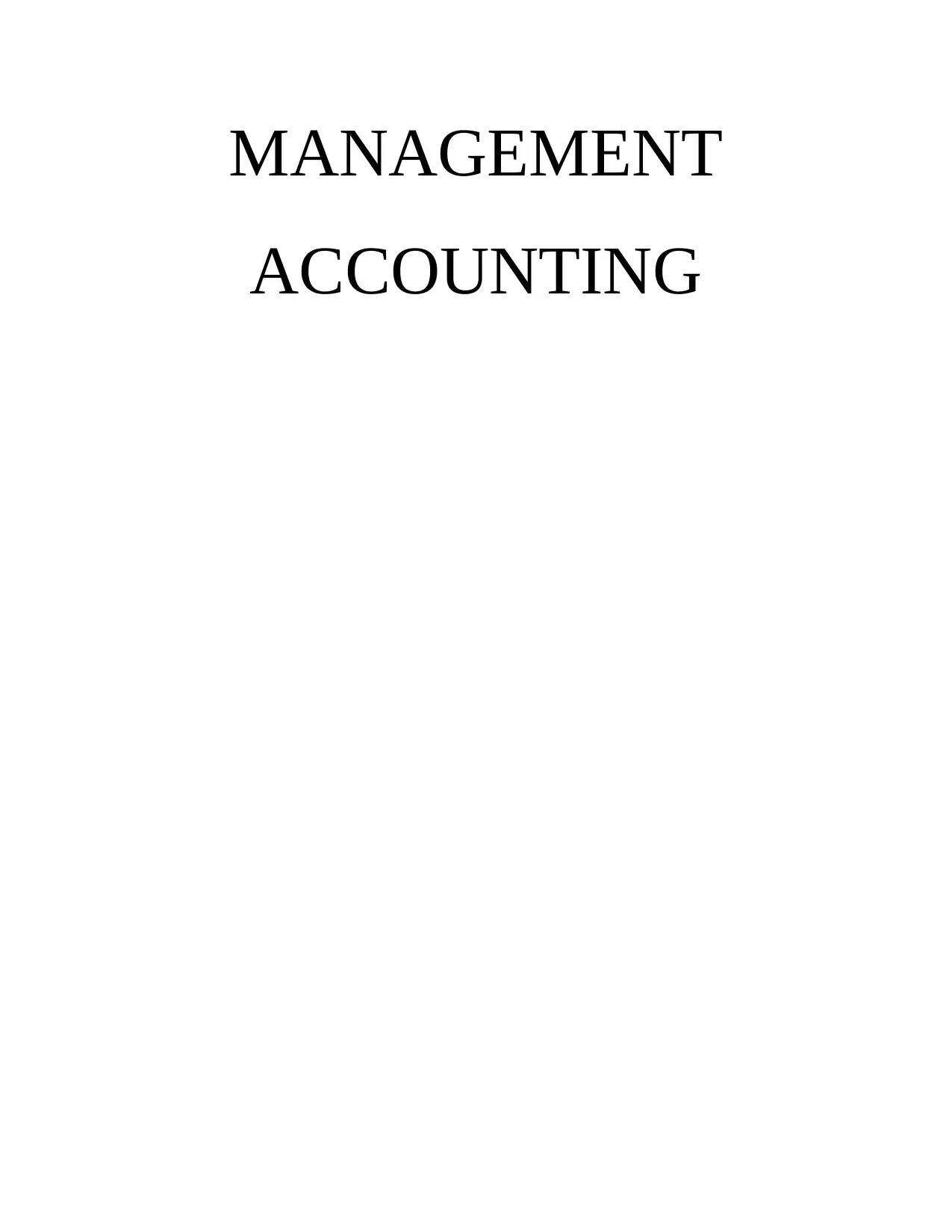
MANAGEMENT
ACCOUNTING
ACCOUNTING
Paraphrase This Document
Need a fresh take? Get an instant paraphrase of this document with our AI Paraphraser

Table of Contents
INTRODUCTION...........................................................................................................................3
PART A...........................................................................................................................................3
PART B............................................................................................................................................8
CONCLUSION..............................................................................................................................10
REFERENCES..............................................................................................................................11
INTRODUCTION...........................................................................................................................3
PART A...........................................................................................................................................3
PART B............................................................................................................................................8
CONCLUSION..............................................................................................................................10
REFERENCES..............................................................................................................................11
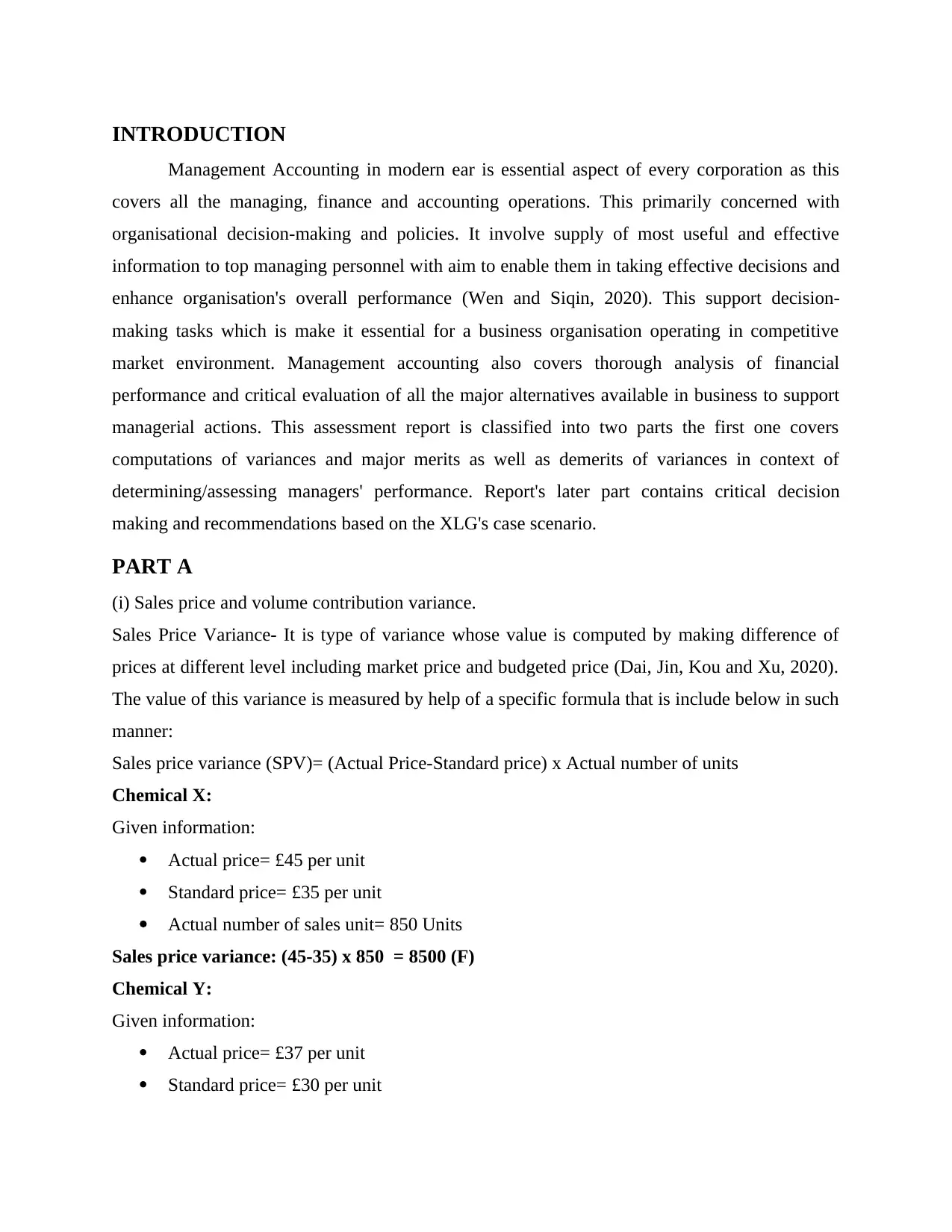
INTRODUCTION
Management Accounting in modern ear is essential aspect of every corporation as this
covers all the managing, finance and accounting operations. This primarily concerned with
organisational decision-making and policies. It involve supply of most useful and effective
information to top managing personnel with aim to enable them in taking effective decisions and
enhance organisation's overall performance (Wen and Siqin, 2020). This support decision-
making tasks which is make it essential for a business organisation operating in competitive
market environment. Management accounting also covers thorough analysis of financial
performance and critical evaluation of all the major alternatives available in business to support
managerial actions. This assessment report is classified into two parts the first one covers
computations of variances and major merits as well as demerits of variances in context of
determining/assessing managers' performance. Report's later part contains critical decision
making and recommendations based on the XLG's case scenario.
PART A
(i) Sales price and volume contribution variance.
Sales Price Variance- It is type of variance whose value is computed by making difference of
prices at different level including market price and budgeted price (Dai, Jin, Kou and Xu, 2020).
The value of this variance is measured by help of a specific formula that is include below in such
manner:
Sales price variance (SPV)= (Actual Price-Standard price) x Actual number of units
Chemical X:
Given information:
Actual price= £45 per unit
Standard price= £35 per unit
Actual number of sales unit= 850 Units
Sales price variance: (45-35) x 850 = 8500 (F)
Chemical Y:
Given information:
Actual price= £37 per unit
Standard price= £30 per unit
Management Accounting in modern ear is essential aspect of every corporation as this
covers all the managing, finance and accounting operations. This primarily concerned with
organisational decision-making and policies. It involve supply of most useful and effective
information to top managing personnel with aim to enable them in taking effective decisions and
enhance organisation's overall performance (Wen and Siqin, 2020). This support decision-
making tasks which is make it essential for a business organisation operating in competitive
market environment. Management accounting also covers thorough analysis of financial
performance and critical evaluation of all the major alternatives available in business to support
managerial actions. This assessment report is classified into two parts the first one covers
computations of variances and major merits as well as demerits of variances in context of
determining/assessing managers' performance. Report's later part contains critical decision
making and recommendations based on the XLG's case scenario.
PART A
(i) Sales price and volume contribution variance.
Sales Price Variance- It is type of variance whose value is computed by making difference of
prices at different level including market price and budgeted price (Dai, Jin, Kou and Xu, 2020).
The value of this variance is measured by help of a specific formula that is include below in such
manner:
Sales price variance (SPV)= (Actual Price-Standard price) x Actual number of units
Chemical X:
Given information:
Actual price= £45 per unit
Standard price= £35 per unit
Actual number of sales unit= 850 Units
Sales price variance: (45-35) x 850 = 8500 (F)
Chemical Y:
Given information:
Actual price= £37 per unit
Standard price= £30 per unit
⊘ This is a preview!⊘
Do you want full access?
Subscribe today to unlock all pages.

Trusted by 1+ million students worldwide
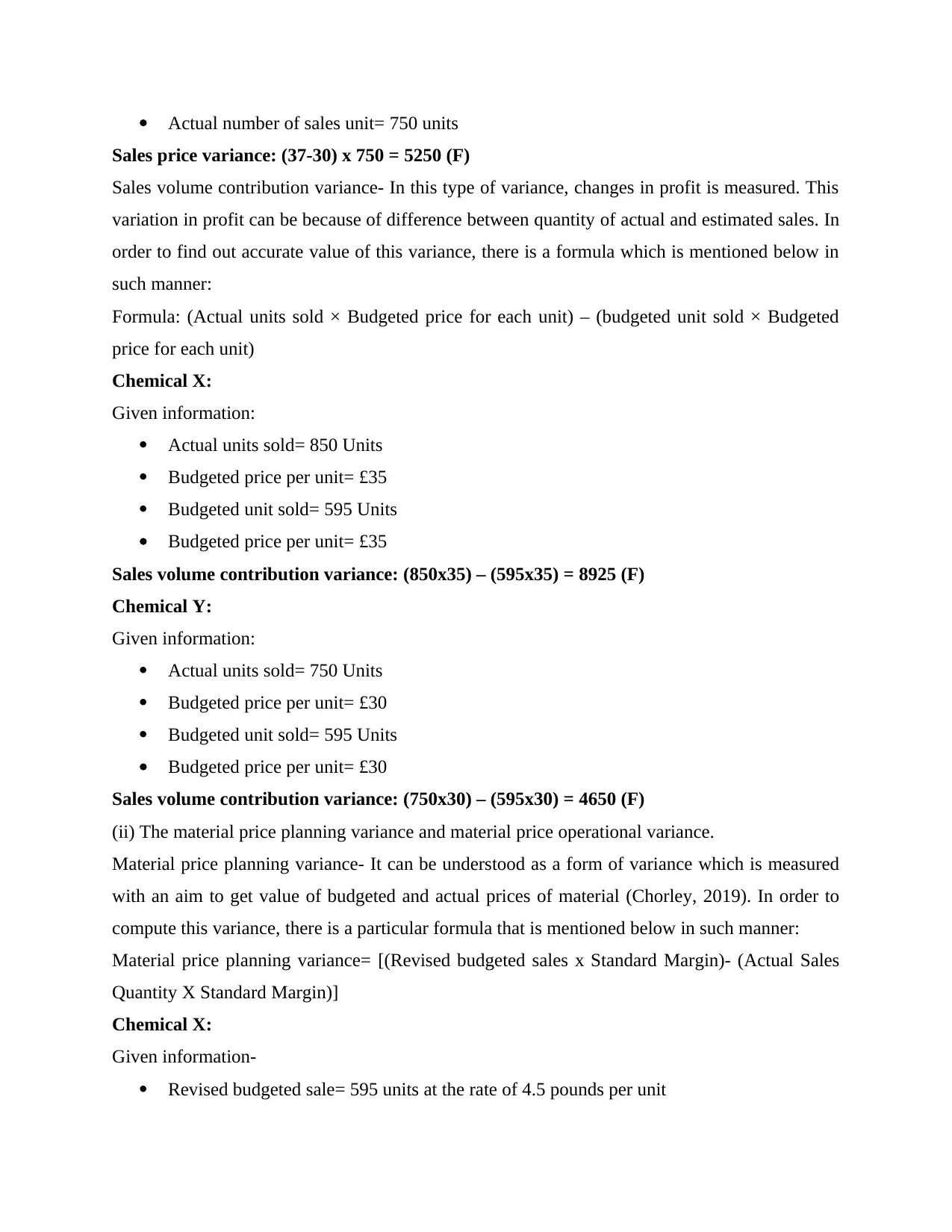
Actual number of sales unit= 750 units
Sales price variance: (37-30) x 750 = 5250 (F)
Sales volume contribution variance- In this type of variance, changes in profit is measured. This
variation in profit can be because of difference between quantity of actual and estimated sales. In
order to find out accurate value of this variance, there is a formula which is mentioned below in
such manner:
Formula: (Actual units sold × Budgeted price for each unit) – (budgeted unit sold × Budgeted
price for each unit)
Chemical X:
Given information:
Actual units sold= 850 Units
Budgeted price per unit= £35
Budgeted unit sold= 595 Units
Budgeted price per unit= £35
Sales volume contribution variance: (850x35) – (595x35) = 8925 (F)
Chemical Y:
Given information:
Actual units sold= 750 Units
Budgeted price per unit= £30
Budgeted unit sold= 595 Units
Budgeted price per unit= £30
Sales volume contribution variance: (750x30) – (595x30) = 4650 (F)
(ii) The material price planning variance and material price operational variance.
Material price planning variance- It can be understood as a form of variance which is measured
with an aim to get value of budgeted and actual prices of material (Chorley, 2019). In order to
compute this variance, there is a particular formula that is mentioned below in such manner:
Material price planning variance= [(Revised budgeted sales x Standard Margin)- (Actual Sales
Quantity X Standard Margin)]
Chemical X:
Given information-
Revised budgeted sale= 595 units at the rate of 4.5 pounds per unit
Sales price variance: (37-30) x 750 = 5250 (F)
Sales volume contribution variance- In this type of variance, changes in profit is measured. This
variation in profit can be because of difference between quantity of actual and estimated sales. In
order to find out accurate value of this variance, there is a formula which is mentioned below in
such manner:
Formula: (Actual units sold × Budgeted price for each unit) – (budgeted unit sold × Budgeted
price for each unit)
Chemical X:
Given information:
Actual units sold= 850 Units
Budgeted price per unit= £35
Budgeted unit sold= 595 Units
Budgeted price per unit= £35
Sales volume contribution variance: (850x35) – (595x35) = 8925 (F)
Chemical Y:
Given information:
Actual units sold= 750 Units
Budgeted price per unit= £30
Budgeted unit sold= 595 Units
Budgeted price per unit= £30
Sales volume contribution variance: (750x30) – (595x30) = 4650 (F)
(ii) The material price planning variance and material price operational variance.
Material price planning variance- It can be understood as a form of variance which is measured
with an aim to get value of budgeted and actual prices of material (Chorley, 2019). In order to
compute this variance, there is a particular formula that is mentioned below in such manner:
Material price planning variance= [(Revised budgeted sales x Standard Margin)- (Actual Sales
Quantity X Standard Margin)]
Chemical X:
Given information-
Revised budgeted sale= 595 units at the rate of 4.5 pounds per unit
Paraphrase This Document
Need a fresh take? Get an instant paraphrase of this document with our AI Paraphraser
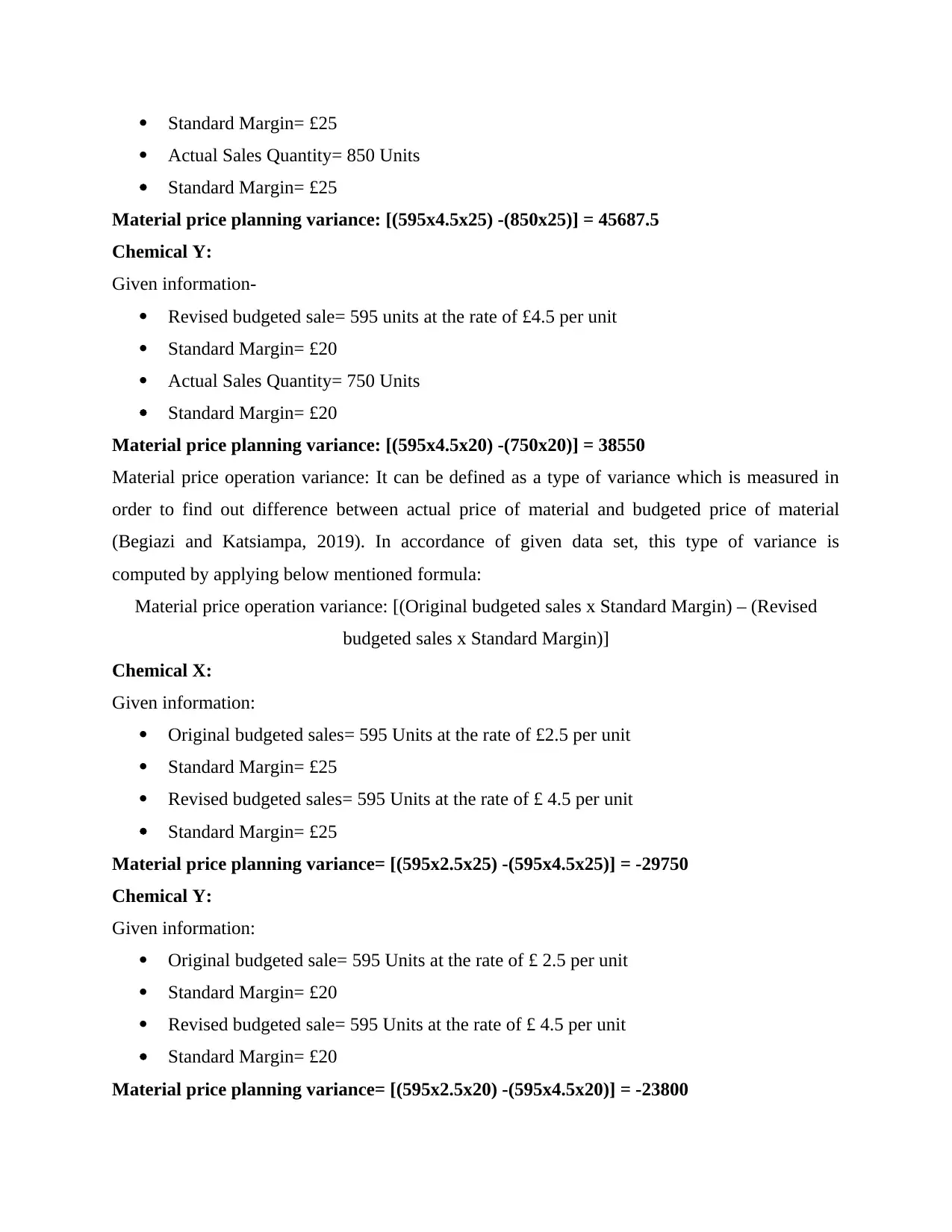
Standard Margin= £25
Actual Sales Quantity= 850 Units
Standard Margin= £25
Material price planning variance: [(595x4.5x25) -(850x25)] = 45687.5
Chemical Y:
Given information-
Revised budgeted sale= 595 units at the rate of £4.5 per unit
Standard Margin= £20
Actual Sales Quantity= 750 Units
Standard Margin= £20
Material price planning variance: [(595x4.5x20) -(750x20)] = 38550
Material price operation variance: It can be defined as a type of variance which is measured in
order to find out difference between actual price of material and budgeted price of material
(Begiazi and Katsiampa, 2019). In accordance of given data set, this type of variance is
computed by applying below mentioned formula:
Material price operation variance: [(Original budgeted sales x Standard Margin) – (Revised
budgeted sales x Standard Margin)]
Chemical X:
Given information:
Original budgeted sales= 595 Units at the rate of £2.5 per unit
Standard Margin= £25
Revised budgeted sales= 595 Units at the rate of £ 4.5 per unit
Standard Margin= £25
Material price planning variance= [(595x2.5x25) -(595x4.5x25)] = -29750
Chemical Y:
Given information:
Original budgeted sale= 595 Units at the rate of £ 2.5 per unit
Standard Margin= £20
Revised budgeted sale= 595 Units at the rate of £ 4.5 per unit
Standard Margin= £20
Material price planning variance= [(595x2.5x20) -(595x4.5x20)] = -23800
Actual Sales Quantity= 850 Units
Standard Margin= £25
Material price planning variance: [(595x4.5x25) -(850x25)] = 45687.5
Chemical Y:
Given information-
Revised budgeted sale= 595 units at the rate of £4.5 per unit
Standard Margin= £20
Actual Sales Quantity= 750 Units
Standard Margin= £20
Material price planning variance: [(595x4.5x20) -(750x20)] = 38550
Material price operation variance: It can be defined as a type of variance which is measured in
order to find out difference between actual price of material and budgeted price of material
(Begiazi and Katsiampa, 2019). In accordance of given data set, this type of variance is
computed by applying below mentioned formula:
Material price operation variance: [(Original budgeted sales x Standard Margin) – (Revised
budgeted sales x Standard Margin)]
Chemical X:
Given information:
Original budgeted sales= 595 Units at the rate of £2.5 per unit
Standard Margin= £25
Revised budgeted sales= 595 Units at the rate of £ 4.5 per unit
Standard Margin= £25
Material price planning variance= [(595x2.5x25) -(595x4.5x25)] = -29750
Chemical Y:
Given information:
Original budgeted sale= 595 Units at the rate of £ 2.5 per unit
Standard Margin= £20
Revised budgeted sale= 595 Units at the rate of £ 4.5 per unit
Standard Margin= £20
Material price planning variance= [(595x2.5x20) -(595x4.5x20)] = -23800
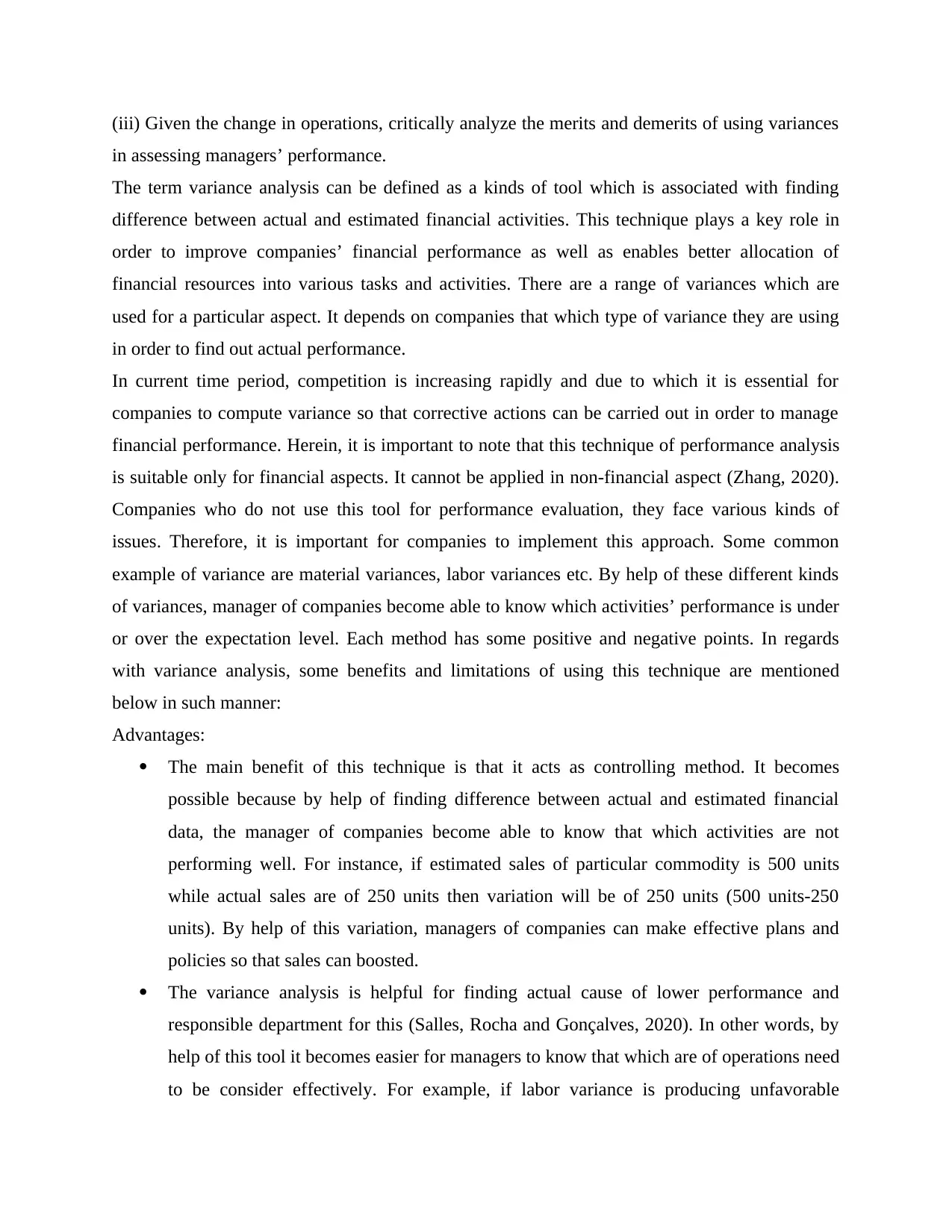
(iii) Given the change in operations, critically analyze the merits and demerits of using variances
in assessing managers’ performance.
The term variance analysis can be defined as a kinds of tool which is associated with finding
difference between actual and estimated financial activities. This technique plays a key role in
order to improve companies’ financial performance as well as enables better allocation of
financial resources into various tasks and activities. There are a range of variances which are
used for a particular aspect. It depends on companies that which type of variance they are using
in order to find out actual performance.
In current time period, competition is increasing rapidly and due to which it is essential for
companies to compute variance so that corrective actions can be carried out in order to manage
financial performance. Herein, it is important to note that this technique of performance analysis
is suitable only for financial aspects. It cannot be applied in non-financial aspect (Zhang, 2020).
Companies who do not use this tool for performance evaluation, they face various kinds of
issues. Therefore, it is important for companies to implement this approach. Some common
example of variance are material variances, labor variances etc. By help of these different kinds
of variances, manager of companies become able to know which activities’ performance is under
or over the expectation level. Each method has some positive and negative points. In regards
with variance analysis, some benefits and limitations of using this technique are mentioned
below in such manner:
Advantages:
The main benefit of this technique is that it acts as controlling method. It becomes
possible because by help of finding difference between actual and estimated financial
data, the manager of companies become able to know that which activities are not
performing well. For instance, if estimated sales of particular commodity is 500 units
while actual sales are of 250 units then variation will be of 250 units (500 units-250
units). By help of this variation, managers of companies can make effective plans and
policies so that sales can boosted.
The variance analysis is helpful for finding actual cause of lower performance and
responsible department for this (Salles, Rocha and Gonçalves, 2020). In other words, by
help of this tool it becomes easier for managers to know that which are of operations need
to be consider effectively. For example, if labor variance is producing unfavorable
in assessing managers’ performance.
The term variance analysis can be defined as a kinds of tool which is associated with finding
difference between actual and estimated financial activities. This technique plays a key role in
order to improve companies’ financial performance as well as enables better allocation of
financial resources into various tasks and activities. There are a range of variances which are
used for a particular aspect. It depends on companies that which type of variance they are using
in order to find out actual performance.
In current time period, competition is increasing rapidly and due to which it is essential for
companies to compute variance so that corrective actions can be carried out in order to manage
financial performance. Herein, it is important to note that this technique of performance analysis
is suitable only for financial aspects. It cannot be applied in non-financial aspect (Zhang, 2020).
Companies who do not use this tool for performance evaluation, they face various kinds of
issues. Therefore, it is important for companies to implement this approach. Some common
example of variance are material variances, labor variances etc. By help of these different kinds
of variances, manager of companies become able to know which activities’ performance is under
or over the expectation level. Each method has some positive and negative points. In regards
with variance analysis, some benefits and limitations of using this technique are mentioned
below in such manner:
Advantages:
The main benefit of this technique is that it acts as controlling method. It becomes
possible because by help of finding difference between actual and estimated financial
data, the manager of companies become able to know that which activities are not
performing well. For instance, if estimated sales of particular commodity is 500 units
while actual sales are of 250 units then variation will be of 250 units (500 units-250
units). By help of this variation, managers of companies can make effective plans and
policies so that sales can boosted.
The variance analysis is helpful for finding actual cause of lower performance and
responsible department for this (Salles, Rocha and Gonçalves, 2020). In other words, by
help of this tool it becomes easier for managers to know that which are of operations need
to be consider effectively. For example, if labor variance is producing unfavorable
⊘ This is a preview!⊘
Do you want full access?
Subscribe today to unlock all pages.

Trusted by 1+ million students worldwide
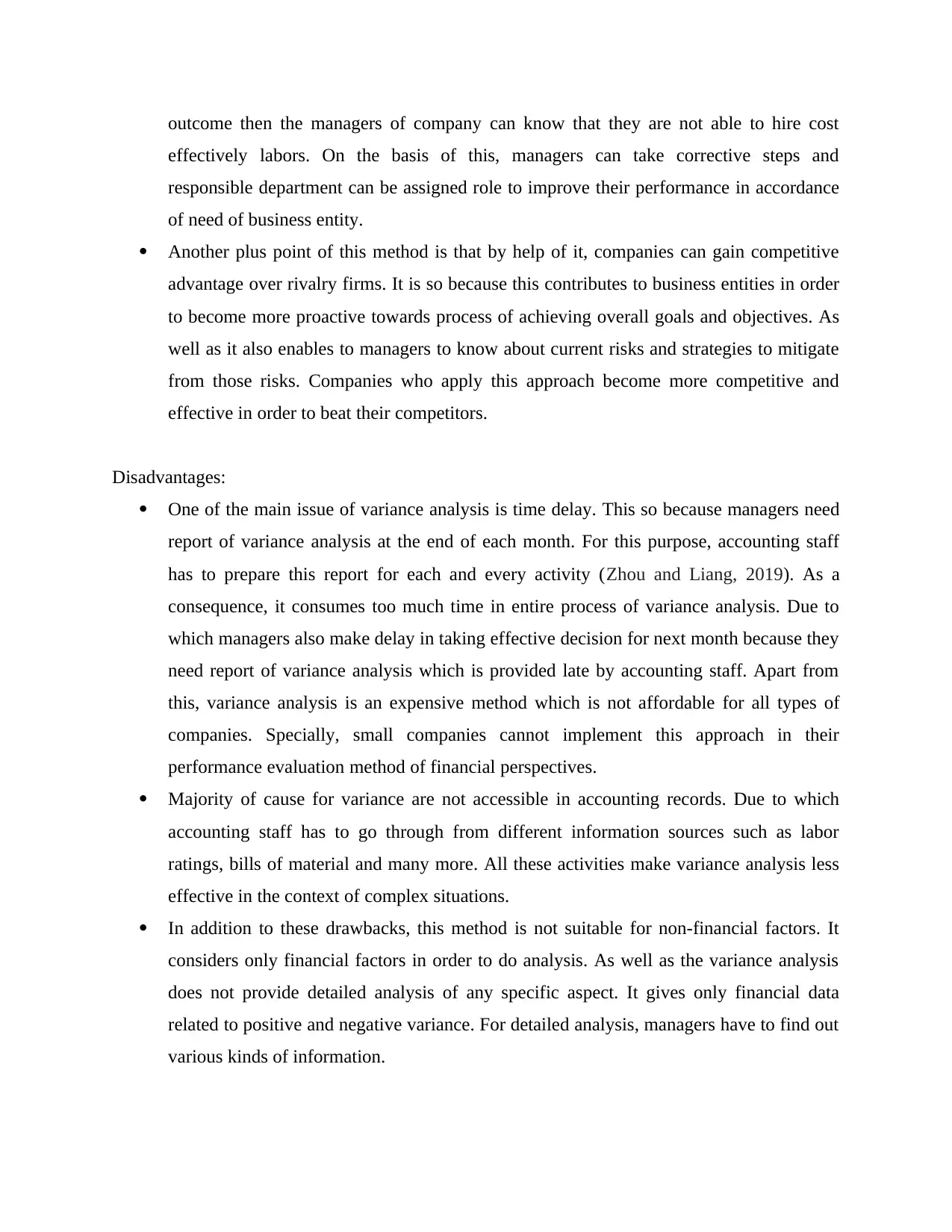
outcome then the managers of company can know that they are not able to hire cost
effectively labors. On the basis of this, managers can take corrective steps and
responsible department can be assigned role to improve their performance in accordance
of need of business entity.
Another plus point of this method is that by help of it, companies can gain competitive
advantage over rivalry firms. It is so because this contributes to business entities in order
to become more proactive towards process of achieving overall goals and objectives. As
well as it also enables to managers to know about current risks and strategies to mitigate
from those risks. Companies who apply this approach become more competitive and
effective in order to beat their competitors.
Disadvantages:
One of the main issue of variance analysis is time delay. This so because managers need
report of variance analysis at the end of each month. For this purpose, accounting staff
has to prepare this report for each and every activity (Zhou and Liang, 2019). As a
consequence, it consumes too much time in entire process of variance analysis. Due to
which managers also make delay in taking effective decision for next month because they
need report of variance analysis which is provided late by accounting staff. Apart from
this, variance analysis is an expensive method which is not affordable for all types of
companies. Specially, small companies cannot implement this approach in their
performance evaluation method of financial perspectives.
Majority of cause for variance are not accessible in accounting records. Due to which
accounting staff has to go through from different information sources such as labor
ratings, bills of material and many more. All these activities make variance analysis less
effective in the context of complex situations.
In addition to these drawbacks, this method is not suitable for non-financial factors. It
considers only financial factors in order to do analysis. As well as the variance analysis
does not provide detailed analysis of any specific aspect. It gives only financial data
related to positive and negative variance. For detailed analysis, managers have to find out
various kinds of information.
effectively labors. On the basis of this, managers can take corrective steps and
responsible department can be assigned role to improve their performance in accordance
of need of business entity.
Another plus point of this method is that by help of it, companies can gain competitive
advantage over rivalry firms. It is so because this contributes to business entities in order
to become more proactive towards process of achieving overall goals and objectives. As
well as it also enables to managers to know about current risks and strategies to mitigate
from those risks. Companies who apply this approach become more competitive and
effective in order to beat their competitors.
Disadvantages:
One of the main issue of variance analysis is time delay. This so because managers need
report of variance analysis at the end of each month. For this purpose, accounting staff
has to prepare this report for each and every activity (Zhou and Liang, 2019). As a
consequence, it consumes too much time in entire process of variance analysis. Due to
which managers also make delay in taking effective decision for next month because they
need report of variance analysis which is provided late by accounting staff. Apart from
this, variance analysis is an expensive method which is not affordable for all types of
companies. Specially, small companies cannot implement this approach in their
performance evaluation method of financial perspectives.
Majority of cause for variance are not accessible in accounting records. Due to which
accounting staff has to go through from different information sources such as labor
ratings, bills of material and many more. All these activities make variance analysis less
effective in the context of complex situations.
In addition to these drawbacks, this method is not suitable for non-financial factors. It
considers only financial factors in order to do analysis. As well as the variance analysis
does not provide detailed analysis of any specific aspect. It gives only financial data
related to positive and negative variance. For detailed analysis, managers have to find out
various kinds of information.
Paraphrase This Document
Need a fresh take? Get an instant paraphrase of this document with our AI Paraphraser
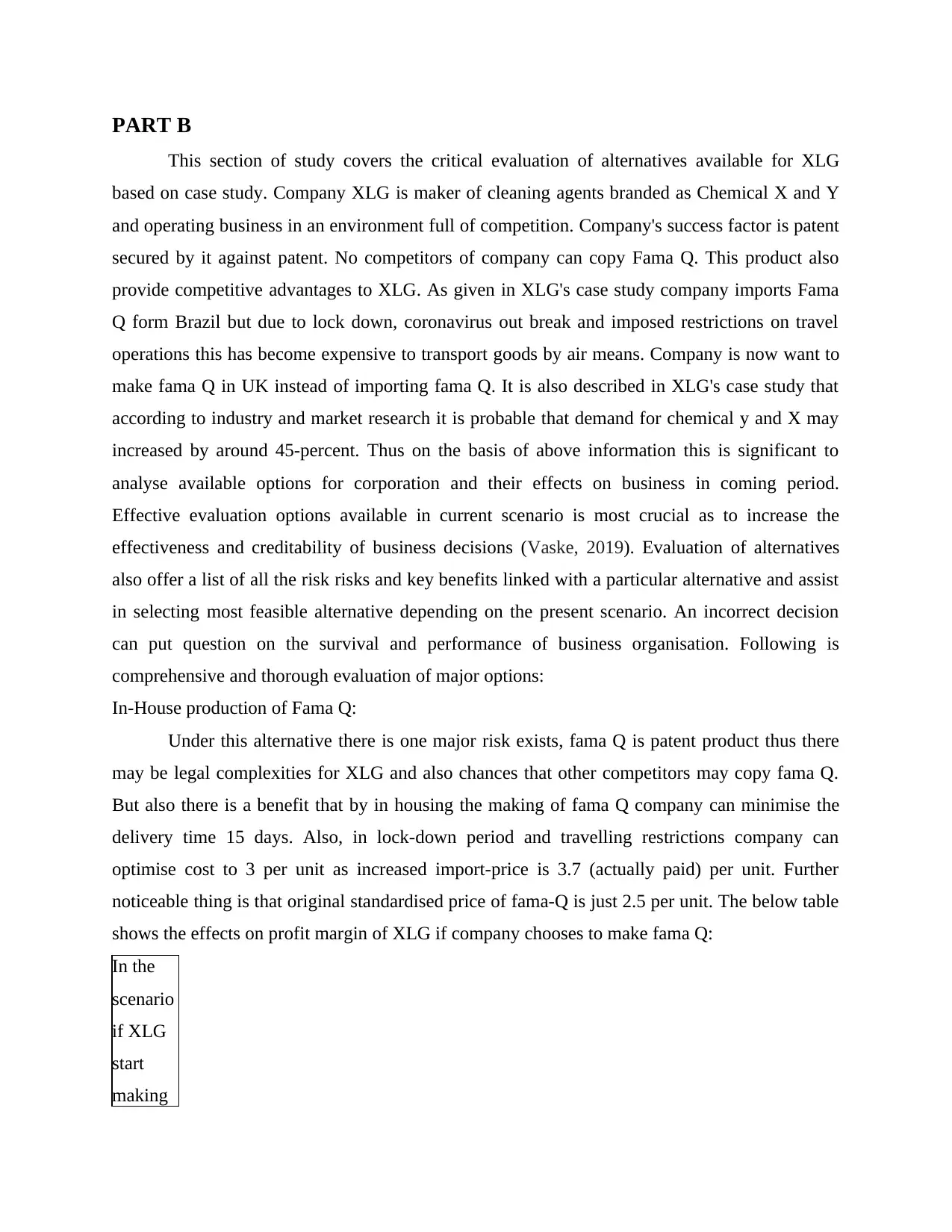
PART B
This section of study covers the critical evaluation of alternatives available for XLG
based on case study. Company XLG is maker of cleaning agents branded as Chemical X and Y
and operating business in an environment full of competition. Company's success factor is patent
secured by it against patent. No competitors of company can copy Fama Q. This product also
provide competitive advantages to XLG. As given in XLG's case study company imports Fama
Q form Brazil but due to lock down, coronavirus out break and imposed restrictions on travel
operations this has become expensive to transport goods by air means. Company is now want to
make fama Q in UK instead of importing fama Q. It is also described in XLG's case study that
according to industry and market research it is probable that demand for chemical y and X may
increased by around 45-percent. Thus on the basis of above information this is significant to
analyse available options for corporation and their effects on business in coming period.
Effective evaluation options available in current scenario is most crucial as to increase the
effectiveness and creditability of business decisions (Vaske, 2019). Evaluation of alternatives
also offer a list of all the risk risks and key benefits linked with a particular alternative and assist
in selecting most feasible alternative depending on the present scenario. An incorrect decision
can put question on the survival and performance of business organisation. Following is
comprehensive and thorough evaluation of major options:
In-House production of Fama Q:
Under this alternative there is one major risk exists, fama Q is patent product thus there
may be legal complexities for XLG and also chances that other competitors may copy fama Q.
But also there is a benefit that by in housing the making of fama Q company can minimise the
delivery time 15 days. Also, in lock-down period and travelling restrictions company can
optimise cost to 3 per unit as increased import-price is 3.7 (actually paid) per unit. Further
noticeable thing is that original standardised price of fama-Q is just 2.5 per unit. The below table
shows the effects on profit margin of XLG if company chooses to make fama Q:
In the
scenario
if XLG
start
making
This section of study covers the critical evaluation of alternatives available for XLG
based on case study. Company XLG is maker of cleaning agents branded as Chemical X and Y
and operating business in an environment full of competition. Company's success factor is patent
secured by it against patent. No competitors of company can copy Fama Q. This product also
provide competitive advantages to XLG. As given in XLG's case study company imports Fama
Q form Brazil but due to lock down, coronavirus out break and imposed restrictions on travel
operations this has become expensive to transport goods by air means. Company is now want to
make fama Q in UK instead of importing fama Q. It is also described in XLG's case study that
according to industry and market research it is probable that demand for chemical y and X may
increased by around 45-percent. Thus on the basis of above information this is significant to
analyse available options for corporation and their effects on business in coming period.
Effective evaluation options available in current scenario is most crucial as to increase the
effectiveness and creditability of business decisions (Vaske, 2019). Evaluation of alternatives
also offer a list of all the risk risks and key benefits linked with a particular alternative and assist
in selecting most feasible alternative depending on the present scenario. An incorrect decision
can put question on the survival and performance of business organisation. Following is
comprehensive and thorough evaluation of major options:
In-House production of Fama Q:
Under this alternative there is one major risk exists, fama Q is patent product thus there
may be legal complexities for XLG and also chances that other competitors may copy fama Q.
But also there is a benefit that by in housing the making of fama Q company can minimise the
delivery time 15 days. Also, in lock-down period and travelling restrictions company can
optimise cost to 3 per unit as increased import-price is 3.7 (actually paid) per unit. Further
noticeable thing is that original standardised price of fama-Q is just 2.5 per unit. The below table
shows the effects on profit margin of XLG if company chooses to make fama Q:
In the
scenario
if XLG
start
making
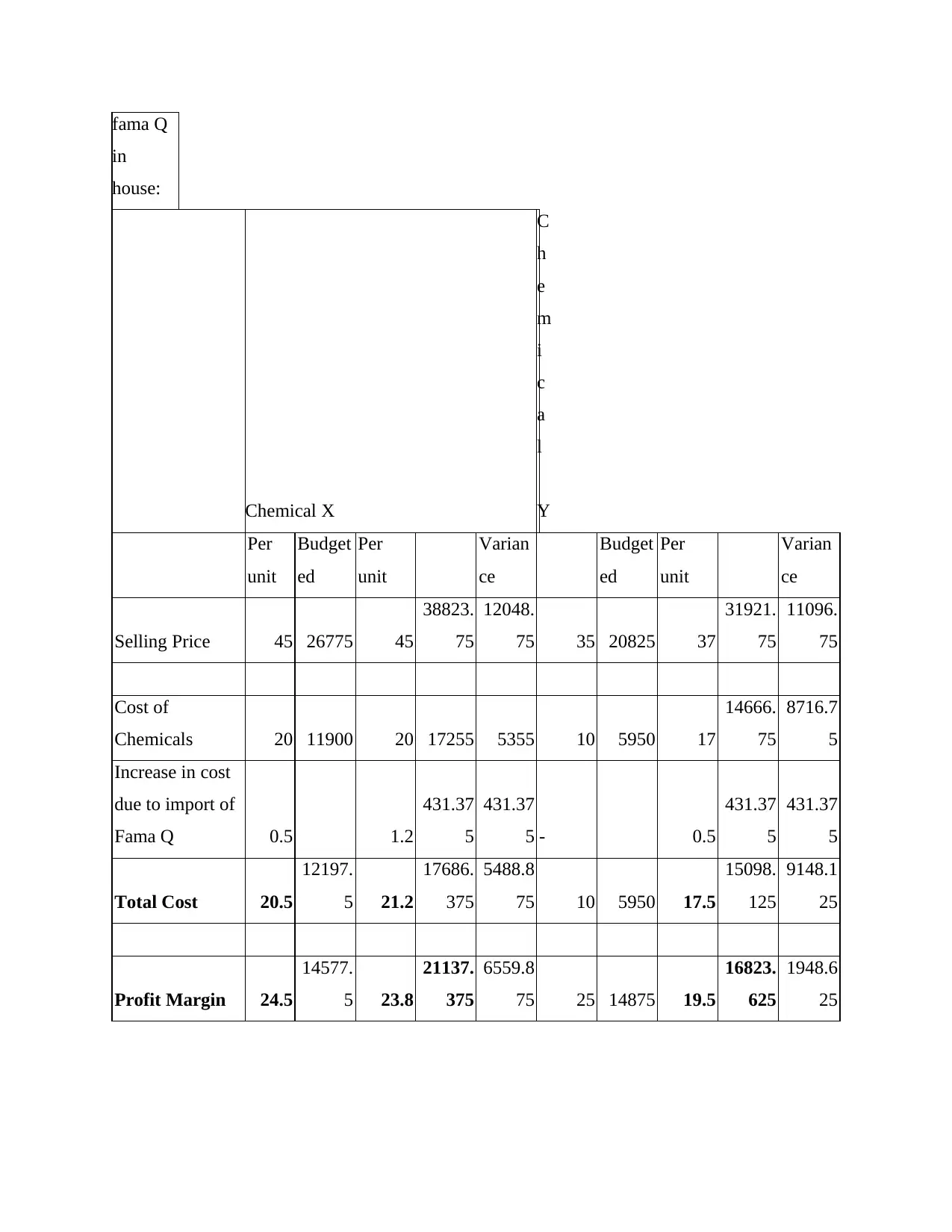
fama Q
in
house:
Chemical X
C
h
e
m
i
c
a
l
Y
Per
unit
Budget
ed
Per
unit
Varian
ce
Budget
ed
Per
unit
Varian
ce
Selling Price 45 26775 45
38823.
75
12048.
75 35 20825 37
31921.
75
11096.
75
Cost of
Chemicals 20 11900 20 17255 5355 10 5950 17
14666.
75
8716.7
5
Increase in cost
due to import of
Fama Q 0.5 1.2
431.37
5
431.37
5 - 0.5
431.37
5
431.37
5
Total Cost 20.5
12197.
5 21.2
17686.
375
5488.8
75 10 5950 17.5
15098.
125
9148.1
25
Profit Margin 24.5
14577.
5 23.8
21137.
375
6559.8
75 25 14875 19.5
16823.
625
1948.6
25
in
house:
Chemical X
C
h
e
m
i
c
a
l
Y
Per
unit
Budget
ed
Per
unit
Varian
ce
Budget
ed
Per
unit
Varian
ce
Selling Price 45 26775 45
38823.
75
12048.
75 35 20825 37
31921.
75
11096.
75
Cost of
Chemicals 20 11900 20 17255 5355 10 5950 17
14666.
75
8716.7
5
Increase in cost
due to import of
Fama Q 0.5 1.2
431.37
5
431.37
5 - 0.5
431.37
5
431.37
5
Total Cost 20.5
12197.
5 21.2
17686.
375
5488.8
75 10 5950 17.5
15098.
125
9148.1
25
Profit Margin 24.5
14577.
5 23.8
21137.
375
6559.8
75 25 14875 19.5
16823.
625
1948.6
25
⊘ This is a preview!⊘
Do you want full access?
Subscribe today to unlock all pages.

Trusted by 1+ million students worldwide
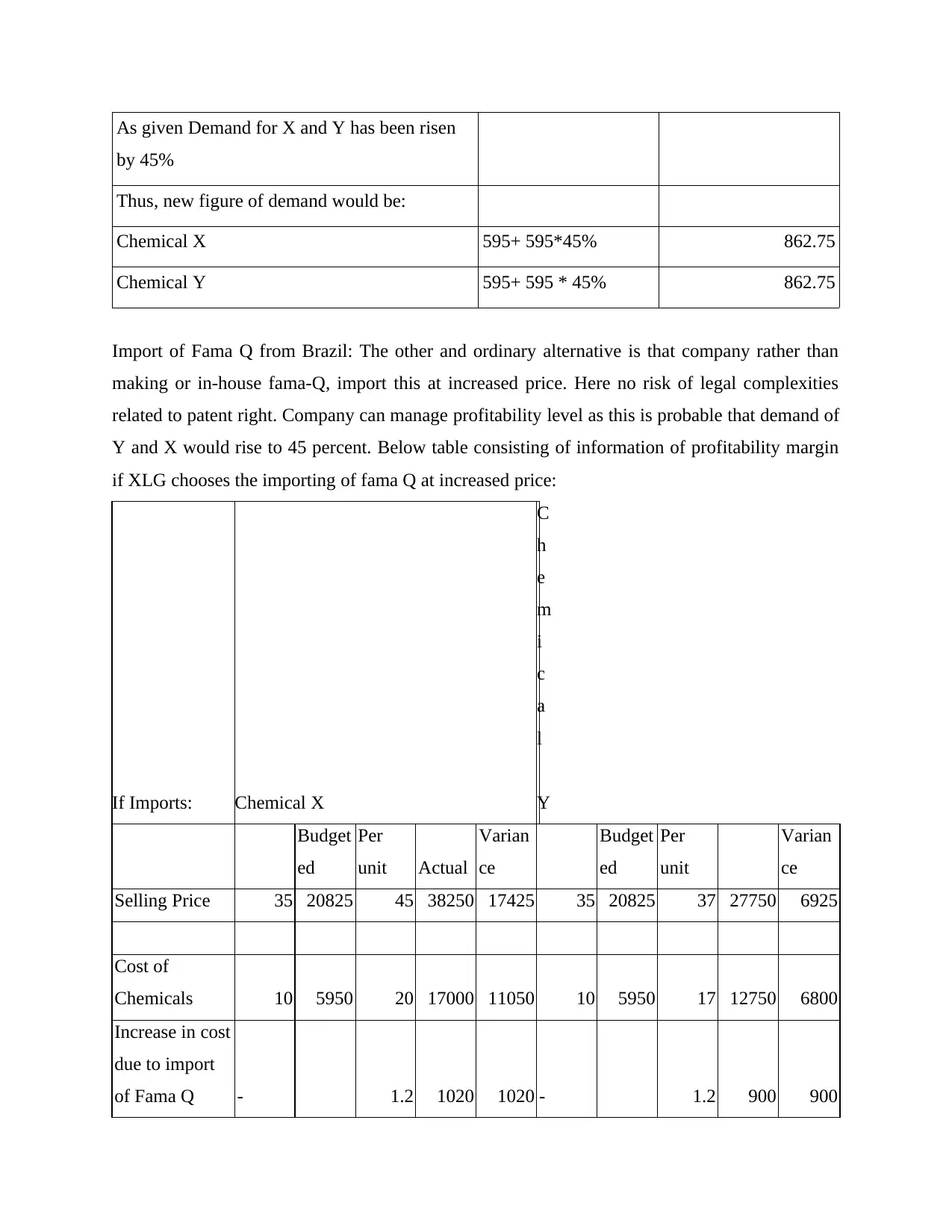
As given Demand for X and Y has been risen
by 45%
Thus, new figure of demand would be:
Chemical X 595+ 595*45% 862.75
Chemical Y 595+ 595 * 45% 862.75
Import of Fama Q from Brazil: The other and ordinary alternative is that company rather than
making or in-house fama-Q, import this at increased price. Here no risk of legal complexities
related to patent right. Company can manage profitability level as this is probable that demand of
Y and X would rise to 45 percent. Below table consisting of information of profitability margin
if XLG chooses the importing of fama Q at increased price:
If Imports: Chemical X
C
h
e
m
i
c
a
l
Y
Budget
ed
Per
unit Actual
Varian
ce
Budget
ed
Per
unit
Varian
ce
Selling Price 35 20825 45 38250 17425 35 20825 37 27750 6925
Cost of
Chemicals 10 5950 20 17000 11050 10 5950 17 12750 6800
Increase in cost
due to import
of Fama Q - 1.2 1020 1020 - 1.2 900 900
by 45%
Thus, new figure of demand would be:
Chemical X 595+ 595*45% 862.75
Chemical Y 595+ 595 * 45% 862.75
Import of Fama Q from Brazil: The other and ordinary alternative is that company rather than
making or in-house fama-Q, import this at increased price. Here no risk of legal complexities
related to patent right. Company can manage profitability level as this is probable that demand of
Y and X would rise to 45 percent. Below table consisting of information of profitability margin
if XLG chooses the importing of fama Q at increased price:
If Imports: Chemical X
C
h
e
m
i
c
a
l
Y
Budget
ed
Per
unit Actual
Varian
ce
Budget
ed
Per
unit
Varian
ce
Selling Price 35 20825 45 38250 17425 35 20825 37 27750 6925
Cost of
Chemicals 10 5950 20 17000 11050 10 5950 17 12750 6800
Increase in cost
due to import
of Fama Q - 1.2 1020 1020 - 1.2 900 900
Paraphrase This Document
Need a fresh take? Get an instant paraphrase of this document with our AI Paraphraser
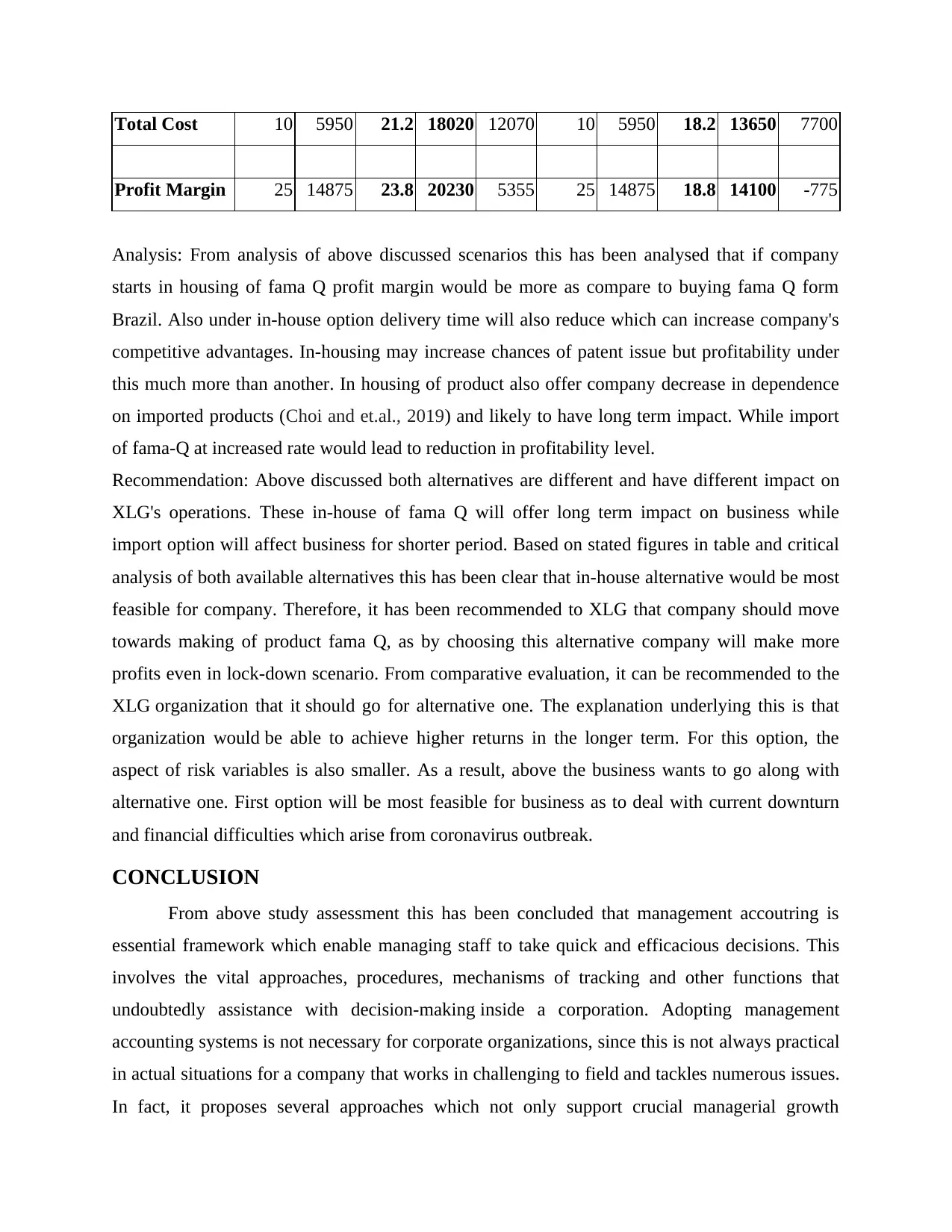
Total Cost 10 5950 21.2 18020 12070 10 5950 18.2 13650 7700
Profit Margin 25 14875 23.8 20230 5355 25 14875 18.8 14100 -775
Analysis: From analysis of above discussed scenarios this has been analysed that if company
starts in housing of fama Q profit margin would be more as compare to buying fama Q form
Brazil. Also under in-house option delivery time will also reduce which can increase company's
competitive advantages. In-housing may increase chances of patent issue but profitability under
this much more than another. In housing of product also offer company decrease in dependence
on imported products (Choi and et.al., 2019) and likely to have long term impact. While import
of fama-Q at increased rate would lead to reduction in profitability level.
Recommendation: Above discussed both alternatives are different and have different impact on
XLG's operations. These in-house of fama Q will offer long term impact on business while
import option will affect business for shorter period. Based on stated figures in table and critical
analysis of both available alternatives this has been clear that in-house alternative would be most
feasible for company. Therefore, it has been recommended to XLG that company should move
towards making of product fama Q, as by choosing this alternative company will make more
profits even in lock-down scenario. From comparative evaluation, it can be recommended to the
XLG organization that it should go for alternative one. The explanation underlying this is that
organization would be able to achieve higher returns in the longer term. For this option, the
aspect of risk variables is also smaller. As a result, above the business wants to go along with
alternative one. First option will be most feasible for business as to deal with current downturn
and financial difficulties which arise from coronavirus outbreak.
CONCLUSION
From above study assessment this has been concluded that management accoutring is
essential framework which enable managing staff to take quick and efficacious decisions. This
involves the vital approaches, procedures, mechanisms of tracking and other functions that
undoubtedly assistance with decision-making inside a corporation. Adopting management
accounting systems is not necessary for corporate organizations, since this is not always practical
in actual situations for a company that works in challenging to field and tackles numerous issues.
In fact, it proposes several approaches which not only support crucial managerial growth
Profit Margin 25 14875 23.8 20230 5355 25 14875 18.8 14100 -775
Analysis: From analysis of above discussed scenarios this has been analysed that if company
starts in housing of fama Q profit margin would be more as compare to buying fama Q form
Brazil. Also under in-house option delivery time will also reduce which can increase company's
competitive advantages. In-housing may increase chances of patent issue but profitability under
this much more than another. In housing of product also offer company decrease in dependence
on imported products (Choi and et.al., 2019) and likely to have long term impact. While import
of fama-Q at increased rate would lead to reduction in profitability level.
Recommendation: Above discussed both alternatives are different and have different impact on
XLG's operations. These in-house of fama Q will offer long term impact on business while
import option will affect business for shorter period. Based on stated figures in table and critical
analysis of both available alternatives this has been clear that in-house alternative would be most
feasible for company. Therefore, it has been recommended to XLG that company should move
towards making of product fama Q, as by choosing this alternative company will make more
profits even in lock-down scenario. From comparative evaluation, it can be recommended to the
XLG organization that it should go for alternative one. The explanation underlying this is that
organization would be able to achieve higher returns in the longer term. For this option, the
aspect of risk variables is also smaller. As a result, above the business wants to go along with
alternative one. First option will be most feasible for business as to deal with current downturn
and financial difficulties which arise from coronavirus outbreak.
CONCLUSION
From above study assessment this has been concluded that management accoutring is
essential framework which enable managing staff to take quick and efficacious decisions. This
involves the vital approaches, procedures, mechanisms of tracking and other functions that
undoubtedly assistance with decision-making inside a corporation. Adopting management
accounting systems is not necessary for corporate organizations, since this is not always practical
in actual situations for a company that works in challenging to field and tackles numerous issues.
In fact, it proposes several approaches which not only support crucial managerial growth
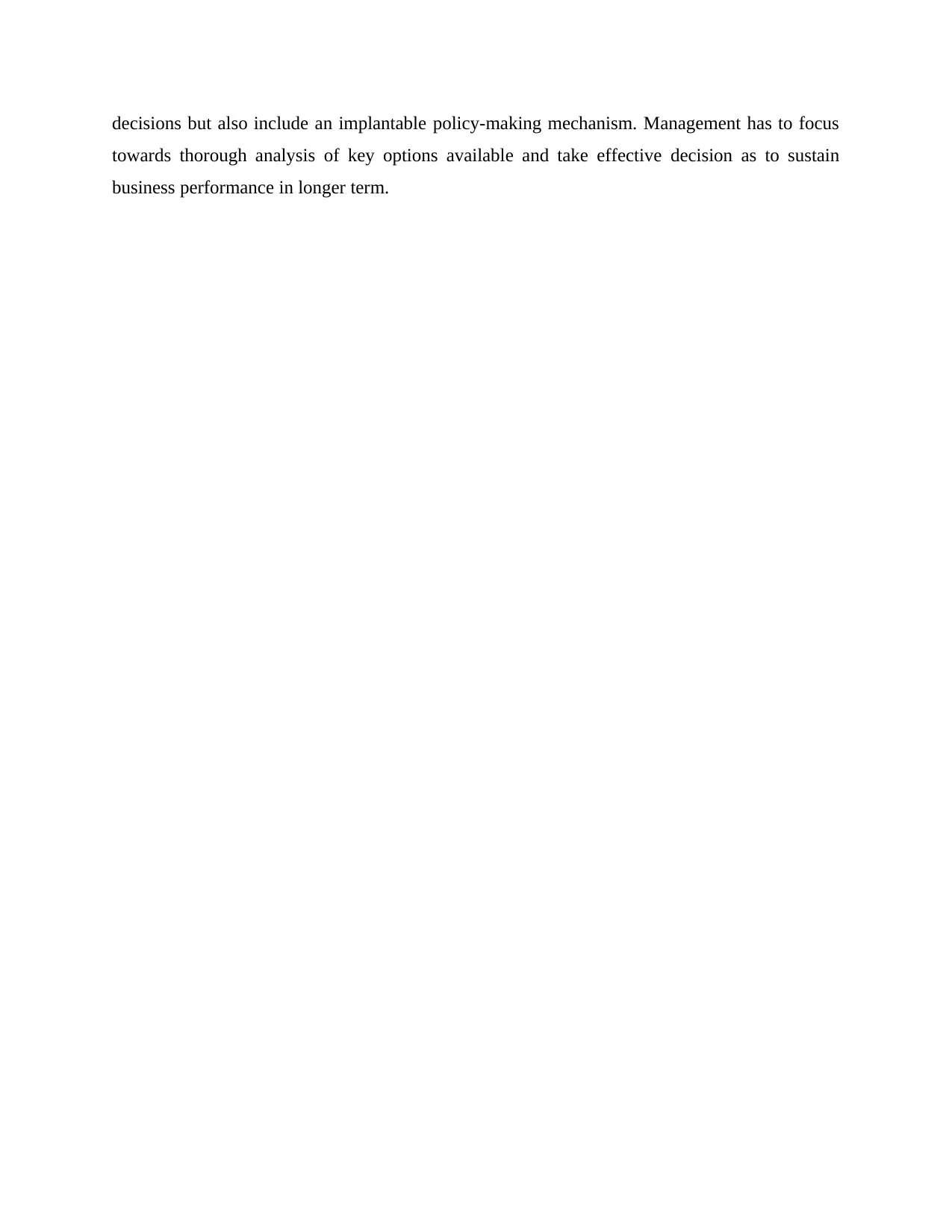
decisions but also include an implantable policy-making mechanism. Management has to focus
towards thorough analysis of key options available and take effective decision as to sustain
business performance in longer term.
towards thorough analysis of key options available and take effective decision as to sustain
business performance in longer term.
⊘ This is a preview!⊘
Do you want full access?
Subscribe today to unlock all pages.

Trusted by 1+ million students worldwide
1 out of 13
Related Documents
Your All-in-One AI-Powered Toolkit for Academic Success.
+13062052269
info@desklib.com
Available 24*7 on WhatsApp / Email
![[object Object]](/_next/static/media/star-bottom.7253800d.svg)
Unlock your academic potential
Copyright © 2020–2025 A2Z Services. All Rights Reserved. Developed and managed by ZUCOL.




